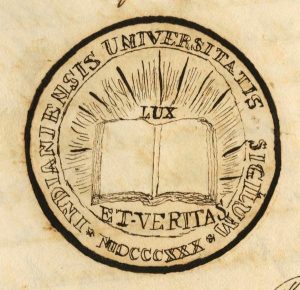By: Rachna Chaudhari, Bicentennial Intern, Class of 2018, Biology, Bloomington

Andrew Wylie was born in 1789 and was the son of an immigrant Irish farmer.
He grew up in Washington County, Pennsylvania where he was a licensed Presbyterian minister. In 1812, he was unanimously elected the president of Jefferson College.
In 1813, Andrew Wylie married Margaret Ritchie, and together they had twelve children.
Only ten of the twelve lived in the Bloomington home. In 1828, Wylie was invited by the trustees of Indiana College to become its first president.
This would be the beginning of a 21-year term as president. Andrew Wylie remains IU’s third longest serving president, and its longest non-Hoosier chief administrator [1].
On September 27, 1829, Andrew and Margaret Wylie and nine of their children left Washington, Pennsylvania, drove four two-horse wagon-loads of furniture to Wheeling and boarded a river boat to Louisville.
There they were met by wagons sent from Bloomington plus a barouche in which Andrew, Margaret, and the younger children rode. They arrived in Bloomington on October 9, 1829.
Imagine this: Bloomington with no cars, a few brick houses, and tiny farms everywhere. 200 years ago, this is exactly what Bloomington looked like.
When Andrew Wylie arrived with Margaret and nine of their children, the population of Bloomington was a mere 1,000 people. Andrew Wylie, to the dismay of his wife, was a frontier settler.
By the 1840s the population had increased to a few thousand. To think, the first class at Indiana University (then Indiana College) had just ten individuals. Today, there are roughly 38,000 undergraduates enrolled at Indiana University.
Not only was Andrew Wylie the college administrator, but he also taught three classes: moral and mental philosophy, political economy, and literature. He also stayed highly involved with his church as a Presbyterian minister. Andrew Wylie was one busy man! Under his guidance, the student body increased, the curriculum was expanded, and the college became a university in 1838 [2].

In 1835, Andrew Wylie built the house which has since been renamed in his honor, Wylie House on 317 E. 2nd Street. The architectural style of the house reflects Wylie’s Pennsylvania origins. It is believed he did this to make his wife feel more at home. When Andrew Wylie built the beautiful “mansion on a hill,” Bloomington’s streetscape mainly consisted of log cabins and a few brick houses.
Wylie’s house definitely stood out in the community [2]. As the weeks go on, I will be travelling back in time to 19th century Bloomington and telling the story of the esteemed Wylie family and their life on the frontier.
 In order to truly relive the 19th century and understand the Wylie family, we must first understand the Wylie family tree (click on the image above to enlarge). The family was quite large, with Margaret birthing a total of twelve children over a span of twenty-two years.
In order to truly relive the 19th century and understand the Wylie family, we must first understand the Wylie family tree (click on the image above to enlarge). The family was quite large, with Margaret birthing a total of twelve children over a span of twenty-two years.
William, Craig Ritchie, John Hosea, Samuel Theophylact, and Jane Melheme all died at fairly young ages: 19, 21, 32, 25, and 29 respectively. John suffered from tuberculosis most of his life, and eventually succumbed to the disease in 1855 [3].

In 2009, during construction of the Morton C. Bradley Jr. Education Center next to the Wylie House, Sherry Wise, the outdoor interpreter of the Wylie House, found artifacts including teapots and bowls.
Indiana University is diligently working to ensure that the loss of such artifacts does not happen again. These finds have the potential to give us a new perspective and insight into the lives of the Wylie family.

With the help of the Glenn Black Lab and Wylie House, I will be analyzing these artifacts along with compiling historical information about the Wylie’s daily lives for my bicentennial project.
The Glenn Black Lab will write a grant proposal for funding to begin a more in depth project on the property.
Robert Mazrim wrote, “Archaeological excavations…help to better define a place and a time…archaeology has a peculiar ability to enhance and also challenge the written word, to uncover the aspects of daily life long since passed” [4].
This is also a goal of the Bicentennial Project; to bring to light the rich history of our amazing university.
References:
- [Museum Brochure], [The President’s Homes Indiana University: Wylie House Museum], Reference Files, Indiana University Archives, Indiana University, Bloomington.
- [Manual], [Wylie House Museum Docent Manual], Reference Files, Indiana University Archives, Indiana University, Bloomington.
- [Letters], Wylie Family Correspondences, Collection C203, Indiana University Archives, Bloomington.
- Mazrim, Robert. The Sangamo Frontier: History & Archaeology in the Shadow of Lincoln. Chicago: The University of Chicago Press, 2007. Print.